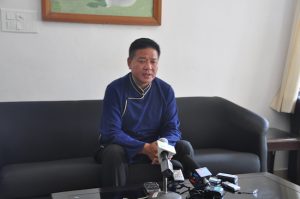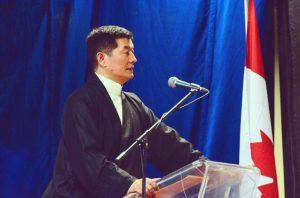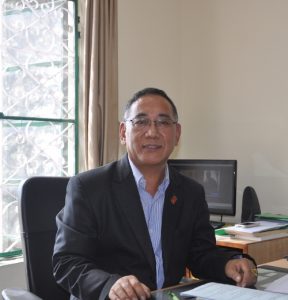
Mr Penpa Tsering
A dispute about the firing of Tibet’s North American representative has brought public scrutiny to a questionable financial transaction undertaken by the Tibetan government.
The rumpus came to the attention of the public on November 7 when it was announced that the North American Representative, Penpa Tsering, was to be replaced. At the time the reasons given for the move were vague.
A general sense of dissatisfaction among sections of the community was reported, with some even suggesting protests and boycott of events where Sikyong Sangay, the President of the Tibetan government-in-exile, is scheduled to attend as there was speculation that this situation had its roots in the acrimonious election for the post of Sikyong last year.
In response the Kashag (Tibetan cabinet) asserted that the issue was handled according to the binding rules and with rightful authority. Officiating President Ven Karma Gelek Yuthok stated that the Kashag did not need to give a clarification over the transfer or firing of any staff and that the issue was an “internal matter”.
This did not quell the discontent over the handling of the situation. Some people even called for more dramatic action to boycott the “Solidarity with Tibet rally for peace and non-violence” on December 10 in New York. Penpa Tsering, the outgoing representative, urged Tibetans in North America to participate for the sake of the broader sense of the Tibetan issue.
A lengthy clarification by the Kashag was then released, citing growing “performance and trust deficit” as well as “insubordination” by former Speaker Penpa Tsering as the three main reasons for its decision. The statement mentioned that Penpa Tsering was “unable to transition from an elected representative to serving as a representative of the Central Tibetan Administration (CTA).” The Kashag stated that Tsering failed to submit crucial reports, did not seek the cabinet’s counsel for appointing a liaison officer, did not coordinate key meetings for the CTA President in the US, committed operational incompetence, failed to step up fund raising initiatives and engaged in back door lobbying against the Tibetan President.
 This clarification, however, opened upfurther speculation, namely the questionable funding of a key project. The clarification by Kashag stated that in September 2015 in Brussels, Belgium, “Representative Penpa Tsering asked whether US$1.5 million from the Tibet Fund used to purchase a Washington DC office building was a loan. In the presence of all other Representatives, Sikyong clearly explained that it was not a loan, but an amount that Tibet Fund had contributed and did not expect to be paid back. Despite Sikyong’s clarification and without consulting and seeking guidance and approval from Kashag and Department of Information and International Relations (DIIR), Representative Penpa Tsering reported to CTA auditors that a loan payment for Office of Tibet Washington DC office was outstanding. All the funds received and spent towards the purchase of the Office of Tibet building in Washington, DC is clearly documented, audited and fully accounted. CTA has all the relevant documents.”
This clarification, however, opened upfurther speculation, namely the questionable funding of a key project. The clarification by Kashag stated that in September 2015 in Brussels, Belgium, “Representative Penpa Tsering asked whether US$1.5 million from the Tibet Fund used to purchase a Washington DC office building was a loan. In the presence of all other Representatives, Sikyong clearly explained that it was not a loan, but an amount that Tibet Fund had contributed and did not expect to be paid back. Despite Sikyong’s clarification and without consulting and seeking guidance and approval from Kashag and Department of Information and International Relations (DIIR), Representative Penpa Tsering reported to CTA auditors that a loan payment for Office of Tibet Washington DC office was outstanding. All the funds received and spent towards the purchase of the Office of Tibet building in Washington, DC is clearly documented, audited and fully accounted. CTA has all the relevant documents.”
This is not consistent with other statements made to the public and accounting authorities. An audit report available on the Tibet Fund website stated that on “March 31, 2014 the Fund entered into a US$1.5 million Loan Agreement with The Office of Tibet to purchase a building that will then be partially subleased by the Fund. The loan is partially collateralised by a lease agreement between the Fund and The Office of Tibet in an aggregate amount of US$425,000. The loan matures on March 31, 2043 at which point the balloon payment of US$1.5 million will be due. The interest rate is 1% and the interest income for the year ended December 31, 2015 was US$15,000. The amount outstanding as of December 31, 2014 is US$1.5 million.”
Sikyong then responded to queries on the “loan” of US$1.5 million from the Tibet Fund, saying the non-profit organisation had to record the amount as a loan due to legal and regulation-bound reasons.
Former Speaker Penpa Tsering told a Tibetan media agency that he will respond to the allegations soon after November 30.

Mr Ngodup Tsering
Education minister Ngodup Tsering will take charge of the North America office at the beginning of December.
Phayul notes that larger questions now loom as to the operational integrity of non-profit organisations and offices under the CTA and how this development could affect funding from foreign governments in the years to come, if irregularities surface.
Protest in Dharamshala and DC
People have taken to the streets in protest in both Dharamshala and in Washington DC, concerned about the events surrounding Penpa Tsering’s replacement. People gathered near the Central Tibetan Administration offices in Dharmashala waving banners proclaiming “Don’t misuse power” and “Do not destroy His Holiness’s legacy” and submitting a memorandum to the Kashag, who have promised to follow up. In Washington DC, Tibetans with banners demonstrated outside the Office of Tibet during the handover to the new North American representative, making clear their protest is against Sikyong Lobsang Sangay and not the government-in-exile.




 Print
Print Email
Email